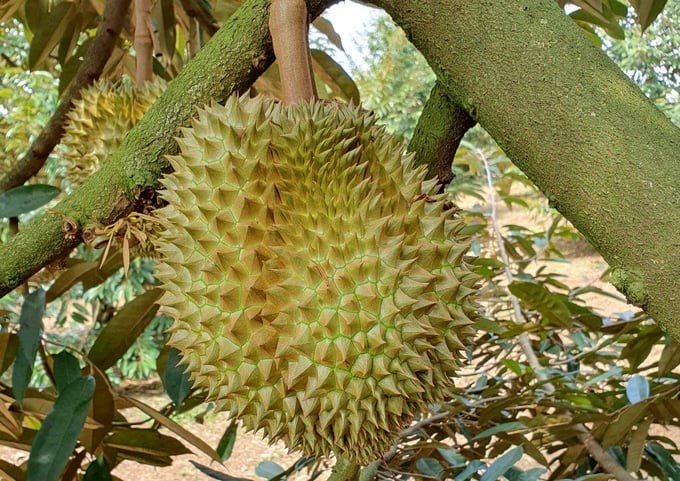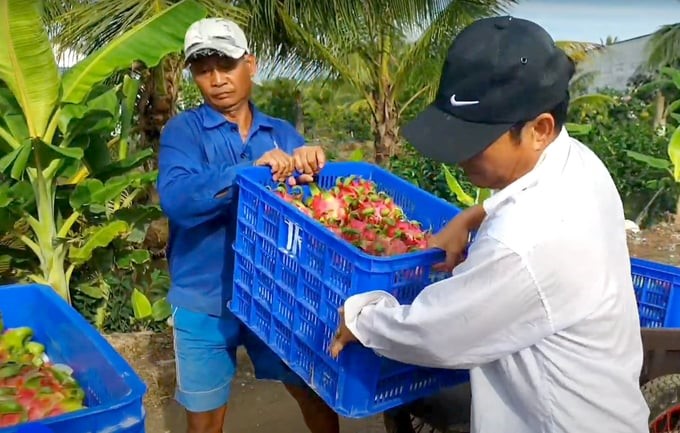May 16, 2025 | 09:52 GMT +7
May 16, 2025 | 09:52 GMT +7
Hotline: 0913.378.918
May 16, 2025 | 09:52 GMT +7
Hotline: 0913.378.918

Mr. Dang Phuc Nguyen, General Secretary of Vietnam Fruit and Vegetables Association. Photo: Thanh Son.
Continuing the strong growth momentum in 2023, fruit and vegetable exports in the first half of this year have grown very impressively, being one of the bright spots in the agricultural sector's export activities.
Statistics from the General Department of Vietnam Customs show that in the first 6 months of the year, fruit and vegetable exports reached USD 3.33 billion, up 24.3% over the same period in 2023. In terms of agricultural products alone, vegetables and fruits are ranking No. 1 in export turnover. In terms of agricultural, forestry, and fishery products, vegetables and fruits are ranked 3rd after wood and seafood.
Mr. Dang Phuc Nguyen, General Secretary of the Vietnam Fruit and Vegetables Association (VINAFRUIT), said that it is estimated that in July, fruit and vegetable exports reached more than USD 477 million, bringing exports in the first 7 months of the year to an estimated USD 3.8 million.
What are the reasons that have helped fruit and vegetable exports continue to grow impressively in the first half of this year, Mr. Dang Phuc Nguyen?
The success of fruit and vegetable exports in the first half of this year has both remote and proximate causes. The remote cause is new geopolitical tensions occurring in early 2024, especially the crisis in the Red Sea that has blocked the flow of container shipping from East to West and vice versa. To ensure safety, cargo ships from East to West and vice versa were forced to go around the Cape of Good Hope in South Africa, leading to an increase in shipping time and freight fee by 3–4 times compared to 2023.
Shipping time has been prolonged by 15–over 20 days, even longer due to the shortage of containers, which has greatly affected fruit and vegetable export activities from the Americas, Europe, and the Middle East to Asia, including China and Northeast Asian countries such as Japan and South Korea.
The lack of water in the Panama Canal also causes goods in general, and vegetables and fruits in particular, from many South American countries to have to go around the South Pole of Americas to go to Asia, leading to a significant increase in shipping costs and time.
Due to prolonged shipping time and rising costs, Asian markets with great demand for fruit and vegetable consumption have turned to increasing the import of vegetables and fruits from other Asian countries, including Vietnam.

Durian accounts for 40% of fruit and vegetable export turnover. Photo: Thanh Son.
The proximate cause is that, continuing the success in 2023, durian exports continued to grow very strongly in the first half of this year and account for about 40% of fruit and vegetable export turnover.
Durian in Vietnam is increasingly growing in area, output, and quality. At the same time, this year, the number of durian growing area codes and packing facility codes issued is about twice as high as in 2023. These factors cause durian export turnover to increase sharply, pulling in good growth in fruit and vegetable export turnover.
Regarding markets, besides China, a number of other import markets also grew impressively early this year, notably the South Korean market. Previously, South Korea often ranked 3rd or 4th among the largest markets for Vietnamese fruits and vegetables. But in the first half of this year, Korea rose to second place.
In addition to durian, this year also recorded a type of fruit with very good growth compared to 2023, which is banana, especially in the Chinese market. Vietnamese bananas currently account for more than 40% of the market share in China and are the largest supply source for this market. The reason why Vietnamese banana exports to China increased sharply is that banana trees in the Philippines are being severely affected by the bacterial wilt disease, causing the Philippines's banana output to decrease sharply.
Like China, South Korea encounters difficulty importing fruits and vegetables from the Americas, Europe, etc., so this country promotes imports from Asian countries, including Vietnam.
In addition, the export of vegetables and fruits to South Korea grows strongly thanks to the increasingly improved quality of Vietnamese fruits and vegetables. Thanks to increasingly better quality and meeting food safety standards, Vietnamese fruits and vegetables can take advantage of market opportunities and increase penetration into Northeast Asian countries, such as China, South Korea, and Japan.
With the results achieved in the first half of the year, what do you think about fruit and vegetable exports this whole year, sir?
In the past 7 months, we have reached approximately USD 4 billion in fruit and vegetable turnover and have 5 months left to export. With the results achieved and the export capacity in the remaining months, this whole year's fruit and vegetable exports can reach USD 7 billion. Even if this milestone is not reached, this year's fruit and vegetable exports will certainly exceed the record of USD 5.6 billion in 2023 and set a new record for Vietnam's fruit and vegetable industry.
We have bases to believe this. First of all, with the No. 1 export item of durian, there is still the entire Central Highlands region with large area and output, which has only begun to be harvested since July and August and lasts until nearly the end of the year. In addition, off-season durian in the Mekong Delta will be harvested in the last months of the year. Such a large durian output is an important basis for continuing to promote the export of this fruit in the last months of the year.

Long An farmers harvest dragon fruit. Photo: Thanh Son.
In addition to durian, many other fruits also have good export prospects in the last months of the year, such as dragon fruit, mango, banana, etc.
Consumers in Northeast Asian countries such as China, Japan, and South Korea love tropical fruits because of their attractive aroma, such as durian, mango, etc. This is an opportunity to continue to promote fruit exports to these markets.
The fruit and vegetable industry is looking forward to the signing of protocols allowing the export of frozen durian and fresh coconut to China. If the protocols are signed, what is the export potential of these two products, sir?
Frozen durian and fresh coconut are both products that are in great demand in the Chinese market. If fresh coconut and frozen durian are allowed to be officially exported to China, then in the first years, these two items can bring in about USD 500 million/year for Vietnam's fruit and vegetable exports.
I calculate this number because, in terms of frozen durian production, there are currently only a few small-scale factories producing goods to export to markets such as the US, Europe, Thailand, etc., with a total turnover of about USD 130–140 million/year.
When Vietnam is allowed to export frozen durian to China, companies will begin to gradually increase the scale of production of this product. In the immediate future, they will expand existing factories to double their current scale, bringing frozen durian exports to about USD 150–200 million. Fresh coconut exports to China can reach about USD 200–300 million in the first years.
After 1-2 years, when realizing that frozen durian exports to the Chinese market have become stable and effective, companies will boldly invest in expanding factories and increasing processing capacity, thereby helping increase the export turnover of this product.
Thank you, sir!
Translated by Thu Huyen

(VAN) Japan's efforts to lower the price of rice through the release of its stockpile may finally be making some progress, albeit at a snail's pace.

(VAN) U.S. tariffs are not only a 'shock', but also an opportunity for Vietnamese businesses to renew their mindset toward comprehensive development.

(VAN) As Bac Giang lychee enters the harvest season, Minister Do Duc Duy expects that the fruit will contribute greatly to agricultural exports due to standardized production and deep processing.

(VAN) Consumers have shown a preference for free-range eggs, but those farming systems are more vulnerable to biosecurity risks like bird flu.
/2025/05/09/5701-1-184335_301.jpg)
(VAN) Vietnam’s eel exports nearly doubled thanks to a mud-free farming model, opening up new prospects while still facing numerous barriers related to international standards.

(VAN) Minister Do Duc Duy warned that if production is not professionalized and supply chains are not transparent, the U.S. market could become a growth bottleneck.

(VAN) Delegating surveillance responsibilities to local authorities is a cost-saving and efficiency-boosting measure that removes a key bottleneck for enterprises, according to Director General Duong Tat Thang.